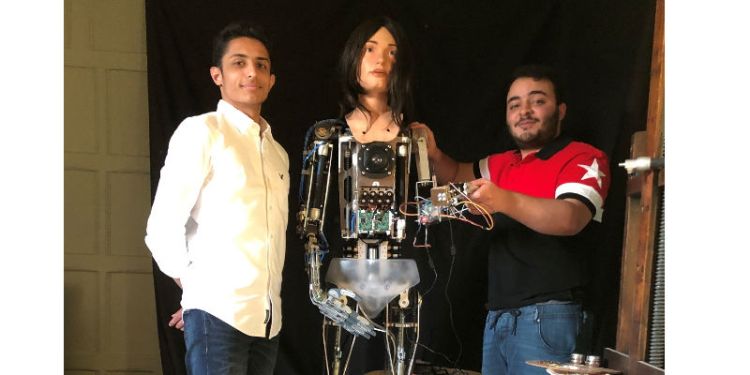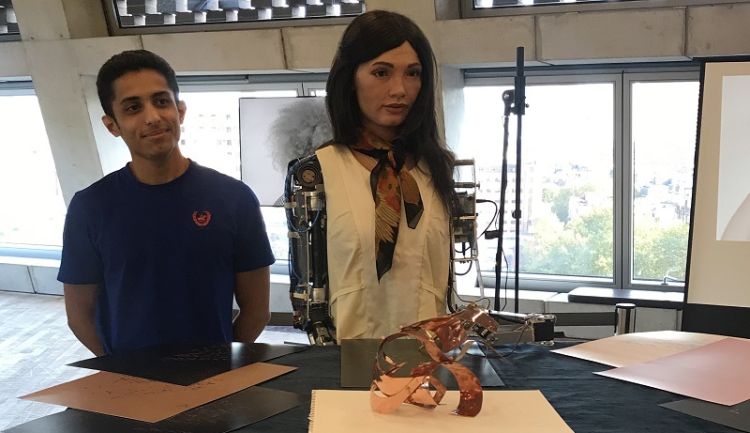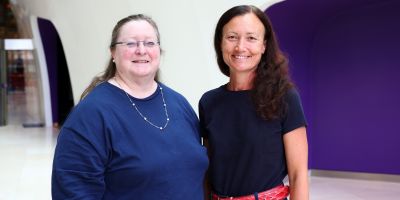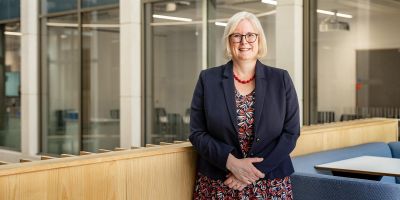Developing Ai-Da, the world’s first ultra-realistic AI robot artist

Students Salah Al Abd and Ziad Abass from the School of Electronic and Electrical Engineering designed Ai-Da's drawing arm and developed the AI algorithms used by the robot artist.
Named after scientist Ada Lovelace, Ai-Da, the world’s first ultra-realistic humanoid AI robot artist was invented by gallery director Aidan Meller. As an artist, Ai-Da draws, sculpts and creates collaborative paintings with human.
Ai-Da has received much publicity since she opened her first solo exhibition “Unsecured Futures” at the Barn Gallery, St John’s College, University of Oxford in the Summer of 2019. She has been interviewed on TV shows such as Good Morning Britain, BBC’s The One Show and performed at global events including Arts Electronica in Austria, Harper’s Bazaar in Dubai, the V&A in London, and the Design Museum in London.
Ai-Da is currently exhibiting at “Forever Is Now”, Egypt’s First Contemporary Art Exhibition at Giza Pyramids and the surrounding Giza Plateau in 4500 years. Organised by Art D'Égypte, the 4th annual exhibition is held with the support from the Egyptian Ministry of Antiquities and Tourism, Egyptian Ministry of Foreign Affairs, and the patronage of UNESCO.
People and news agencies around the world were thrilled to find out about Ai-Da who blurs the line between AI and creativity

Ai-Da’s arms have been created in collaboration with Salaheldin Al Abd and Ziad Abass, both undergraduate students from the School of Electronic and Electrical Engineering here at the University of Leeds. Salah and Ziad designed Ai-Da’s drawing arm and developed the AI algorithms used by Ai-Da to create human drawing style inspired by 20th century masters including Pablo Picasso and German painter Max Beckmann.
Ziad said, “We implemented smart algorithms that use computer vision to analyse who Ai-Da sees, then developed a control system that produces a path for her arm to follow, based on her interpretation. We then worked alongside Engineered Arts (the company that built the rest of Ai-Da) to integrate our system with their existing one. We created a critical part of a robot that is the first of its kind. People and news agencies around the world were thrilled to find out about Ai-Da who blurs the line between AI and creativity. The artwork created by her is made to promote discussion about the technological revolution we are in as well as the possible futures of AI.”
We implemented smart algorithms that use computer vision to analyse who Ai-Da sees, then developed a control system that produces a path for her arm to follow, based on her interpretation.

He added, “The fact that we were implementing our skillset from university into such a big, relevant project taught us a lot about how the real world works and how to professionally deal with situations beyond the lecture theatre. This made us readier than ever to think even bigger and become part of more amazing projects in the future.”
Dr Des McLernon (Reader in Signal Processing) the personal tutor for both Salah and Ziad said, “My undergraduate tutees initially discussed with me their proposed contribution to the overall Ai-Da robot, which included the design and build of the sophisticated robotic drawing arm. It required skills in advanced mechanics, image processing, control and artificial intelligence. But as they were doing this in their own time, and not even as a formal Leeds university project, I thought it was completely impossible both in terms of the advanced technical knowledge required and the serious time constraints. But I was spectacularly wrong! I can confidently say (having supervised nearly 50 PhDs) that what they have achieved as undergraduates is truly outstanding and it could even form a part of a good robotics PhD project.”
It required skills in advanced mechanics, image processing, control and artificial intelligence. What they have achieved as undergraduates is truly outstanding.
Both Ziad and Salah are current students studying the Mechatronics and Robotics MEng course. This unique multidisciplinary course offers students the opportunity to study aspects of electronics, mechanical design and artificial intelligence and applying these aspects to the design and manufacture of sophisticated intelligent systems.
Further information
You can find out more about Ai-Da’s artwork process from her website.




